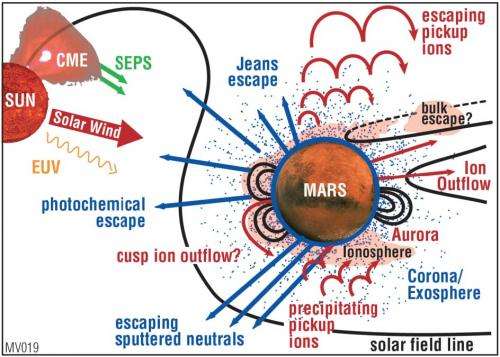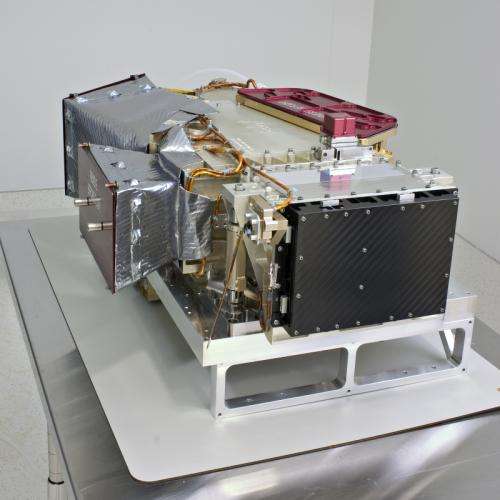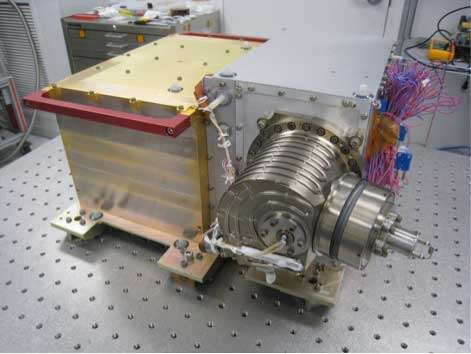MAVEN satellite looks for Mars' missing atmosphere

Ninety kilometers over our heads, the sky is glowing. During the day, the Sun turns the top of our sky into a sea of electrons. They flow over one another without friction, creating plasma. Radio waves that hit these electrons bounce back to Earth, allowing transmissions to literally turns corners and circle the globe. The free electron layer conducts current and responds to magnetic fields. As a result, during solar storms this part of the atmosphere lights up, creating undulating auroras.
While liberated, the electrons devise visual spectacles and technical challenges, but the atoms they leave behind must content themselves with being ions. For this reason, this part of our atmosphere is known as the ionosphere. It's the largest part of our atmosphere, and does a commensurately big job. It absorbs x-rays that would otherwise destroy life on Earth. If it weren't for our atmosphere, Earth might look a good deal more like Mars.
Why Mars doesn't look more like Earth is the subject of ongoing study. The loss of most of the atmosphere is believed to have been a major factor in Mars turning away from the path of water, warmth and habitability. Uncovering where that atmosphere went, when and why is the mission of the Mars Atmosphere and Volatile Evolution (MAVEN) satellite. Scheduled to arrive in September, MAVEN carries with it two instruments designed to probe the remaining ionosphere for clues about the past four billion years, and what will happen going forward.
Our first direct glimpse at ions in the upper atmosphere will be courtesy of the Neutral Gas and Ion Mass Spectrometer (NGIMS). Mass spectrometers like NGIMS are ubiquitous in the world of physical science. They function like the ionosphere itself: by bombarding specimens with electrons and creating ions. This process allows mass spectrometers to divine the contents of a liquid, solid or gas. Small and durable, as well as extremely useful, mass spectrometers have been placed on dozens of satellites and rovers, including NASA's Mars rover Curiosity.
To find Mars' missing atmosphere, NGIMS will search for certain elements and molecules in the Martian ionosphere: helium, argon, nitrogen, oxygen, carbon monoxide, and carbon dioxide. It will note how often each occurs in its neutral and ionized states over 170 miles of sky. It will also count the abundance of heavy and light versions of atoms, also known as isotopes.
Counting isotopes may hold the key to atmospheric loss. The Earth, the Sun and Jupiter have balanced amounts of heavy and light argon isotopes. These bodies have also retained their atmospheres over time. Mars has too much heavy argon and almost no atmosphere. The heavy argon left behind likely represents the original volume of the atmosphere; light argon reflects the lost air.
"The lighter atom in an isotope pair is able to leave the upper atmosphere just a bit faster than the heavier atom," said NGIMS principle investigator Paul Mahaffey, "Our direct measurement of the vertical distribution of these isotope pairs will let us understand the physics of escape better and ultimately understand how much of the atmosphere has been lost in the past several billions of years."

As NGIMS tries to catch light argon in the act of leaving the planet, it will also watch space weather and dust storms change the composition of the atmosphere: mixing up molecules near the bottom of the ionosphere and sending others on one-way trips into deep space.
While NGIMS picks out particles one by one, the UltraViolet Spectrograph (IUVS) will be making sweeping, planetary-wide maps.
"IUVS and NGIMS are backups for each other," said IUVS Principle investigator Nick Schneider, "They both measure the composition & structure of the atmosphere. And we're complementary in measuring different isotopes. IUVS measures the [ratio of heavy to light hydrogen] and NGIMS measures isotopes of heavier elements."
As the most powerful ultraviolent spectrograph to ever be sent to another planet, IUVS is exquisitely sensitive to composition and temperature variations of entire upper atmosphere. The temperature and composition of Mars' atmosphere varies dramatically, not only by altitude, but also by orbit. At perihelion, when Mars is closest to the Sun, it is 40 million miles closer than at aphelion, when it is farthest away. The difference in distance means that much more of the Sun's energy will be reaching Mars during certain times of year. As a result, we expect ultraviolet readings at perihelion and aphelion to vary widely.
"But we anticipate seeing changes from other causes too: solar storms like flares and Coronal Mass Ejections (CME's), and dust storms on Mars too," said Schneider, "These each have the potential to control atmospheric escape on Mars, so we'll be watching them all."
Having a sensor as powerful as IUVS observing Mars over the course of a year will allow us to make atmospheric maps over altitude, time, season and place in space.
Because of its high sensitivity, IUVS has a unique ability to watch light hydrogen leave. Light hydrogen is tied to Mars' lost water, like argon is linked to the missing atmosphere. According to measurements from Curiosity there is abundant deuterium, a hydrogen isotope, near the Martian surface. Deuterium is left behind when sunlight splits water and hydrogen is blown away. If this process of evaporation over eons stripped Mars of its oceans, it should still be occurring. IUVS can tell the difference between heavy deuterium and light hydrogen in the upper atmosphere. The resulting ratio of deuterium to light hydrogen is a measure of how much water has been lost from Mars over time.

In addition to measuring water lost and recording water leaving, IUVS will have one more mission: to watch stars set over the Martian horizon. As distant suns pass through the lower atmosphere, IUVS can tell from the way their light changes how much carbon dioxide is in the part of atmosphere current being studied by NASA's Curiosity rover.
"Gases absorb ultraviolet light with a distinct spectral signature. As the star sets behind Mars' atmosphere, more and more UV light is absorbed by carbon dioxide with its particular spectral shape, and we can calculate how much gas lies between MAVEN and the star at each moment," said Schneider. "From these measurements, we can determine the structure of the atmosphere at altitudes well below where MAVEN will ever fly."
Mounted together on an arm-like platform, IUVS and NGIMS are tucked inside MAVEN's main body, awaiting MAVEN's arrival to Mars. After achieving stable orbit, the arm will extend. Having been deployed, the articulated platform will spin independently of the rest of the satellite. This freedom of motion allows the instruments to face whatever direction the wind is blowing, and to look closely at what that wind contains. If the water that once covered Mars is still fleeing into space, IUVS and NGIMS will catch it in the act. They will look back in time and tell us how much has already been lost.
"This program should let us understand how habitability and the early surface environment of mars might have been for microbial life," said Mahaffy.
The ionosphere on Mars may not glow as brightly as ours, but it has many of the same basic features, and possibly a few we've never seen up close. The arrival of NASA's tenth orbiter will represent our first real window into the top of the Martian sky, which may well hold the keys to its past, present and future. As if in celebration, the arrival of NIGMS, IUVS and MAVEN's six other instruments will be heralded by a very small fireworks display.
"Once we get to Mars, we will actuate a pyrotechnic device that blows off the cap and [the gases brought from Earth] will leave the instrument so we can begin our measurement of the gases in the Martian atmosphere," Mahaffy said.
In other words, as NGIMS vents its familiar atmosphere in favor of Mars' uncharted ionosphere, MAVEN itself will glow.
Provided by Astrobio.net





















